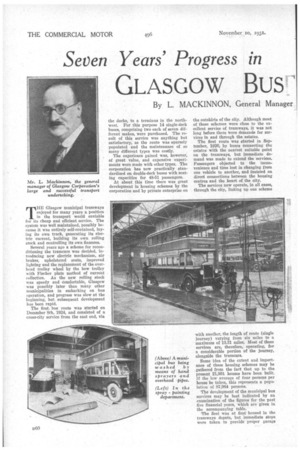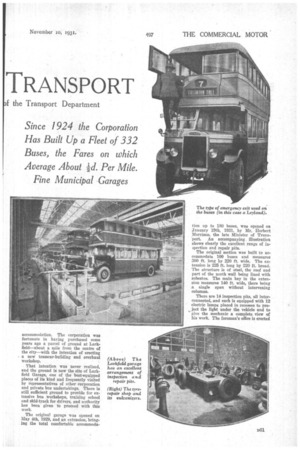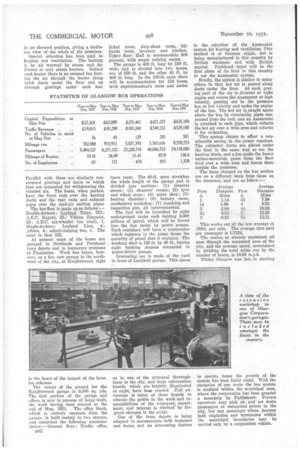Seven Years' Progress in
Page 50

Page 51

Page 52

If you've noticed an error in this article please click here to report it so we can fix it.
GLASGOW Bus
TRANSPORT
By L. MACKINNON, General Manager
f the Transport Department THE Glasgow municipal tramways enjoyed for many years a position in the transport world enviable for its cheap and efficient service. The system was well maintained, possibly because it was entirely self-contained, laying its own track, generating its electric current, building its own rolling stock and controlling its own finances.
Several years ago a scheme for reconditioning the tramcars was decided, introdneing new electric mechanism, air brakes, upholstered seats, improved lighting and the replacement of the overhead trolley wheel by the bow trolley with Fischer plate method of current collection. As the new rolling stock was speedy and comfortable, Glasgow was possibly later than many other municipalities in embarking on bus operation, and progress was slow at the beginning, but subsequent development has been rapid.
The first. bus route was started on December 8th, 1924, and consisted of a cross-city service from the east end, via the docks, to a terminus in the northwest. For this purpose 14 single-deck buses, comprising two each of seven different makes, were purchased. The result of this service was anything but satisfactory, as the route was sparsely populated and the maintenance of so many different types was costly.
The experience gained was, however, of great value, and expensive experiments were made with other types. The corporation has now practically standardized on double-deck buses with seating capacities for 48-51 passengers.
At about this time there was great development in housing schemes by the corporation and by private enterprise on the outskirts of the city. Although most of these schemes were close to the excellent service of tramways, it was not long before there Were demands for services in and through the estates.
The first route was started in September, 1926, by buses connecting the estates with the nearest suitable point on the tramways, but immediate demand was made to extend the services. Passengers objected to the inconvenience and time lost in changing from one vehicle to another, and insisted on direct connections between the housing centres and the heart of the city.
The services now operate, in all cases, through the city, linking up one scheme with another, the length of route (single journey) varying from six miles to a maximum of 13,81 miles. Most of these services are, therefore, operating, for a considerable portion of the journey, alongside the tramcars.
Some idea of the extent and importance of these housing schemes may be gathered from the fact that up to the present 21,001 houses have been built. If the low average of four persons per house be taken, this represents a population of 87,964 persons.
The development of the municipal bus services may be best indicated by an examination of the figures for the past five financial years, which are given in the accompanying table.
The fleet was at first housed in the tramways depots, but immediate steps were taken to provide proper garage
accommodation. The corporation was fortunate in haying purchased some years ago a parcel of ground at Larkfield—about a mile from the centre of the city—with the intention of erecting a new tramcar-building and overhaul workshop.
That intention was never realized, and the ground is now the site of Larkfield Garage, one of the best-equipped places of its kind and frequently visited by representatives of other corporation and private bus undertakings. There is still sufficient ground to provide for extensive bus workshops, training school and skid-track for drivers, and authority has been given to proceed with this work.
The original garage was opened on May 4th, 1029, and an extension, bringing the total comfortable accommoda
tion up to 180 buses, was opened on January 19th, 1.931, by Mr. Elerbert Morrison, the late Minister of Transport. An accompanying illustration shows clearly the excellent range of inspection and repair pits.
The original section was built to accommodate MO buses •and measures 300 ft. long by 220 ft. wide. The extension is 225 ft. long by 220 ft. broad. The structure is of steel, the roof and part of the north wall being lined with asbestos. The main bay in the extension measures 140 ft. wide, there being a single span without intervening columns.
There are 14 inspection pits, all interconnected, and each is equipped with 12 electric lamps placed in recesses to pro-. • ject the light under the vehicle and to give the mechanic a complete view of
• his work. The foreman's office is erected in an elevated position, giving a bird'seye view of the whole of the premises. Special attention has been paid to heating and ventilation. The heating is by air warmed by steam and delivered to unit steam heaters. Behind each heater there is an encased fan forcing the air through the heater along brick ducts under the floor and up through gratings under each bus.
Parallel with these are similarly constructed gratings and ducts to which fans are connected for withdrawing the vitiated air. The buses, when parked, have the front ends over the heating ductsand the rear ends and exhaust pipes over the used-air suction pipes.
The bus fleet is made up as follows:— Double-deckers : Leyland Titan, 272; .A.E:C. Regent, 25; Vulcan Emperor, 25; A.B.C. six-wheeler (ori. trial), 1. Single-deckers : Leyland Lion, 4; Albion, 4; school-training bus, 1. The total is thus 332.
At present some of the buses are garaged in Newlands and Parkhead tram depots and in temporary premises at Finnieston. Work has begun, however, on a fine new garage in the northwest of the city, at Knightswood, right in the heart of the largest of the housing schemes.
The extent of the ground for the Knightswood garage is 9,306 sq. yds. The first portion of the garage and offices is now in process of being built, the work having been started at the end of May, 1931. The office block, which is entirely separate Vom the garage, is built mainly in two storeys, and comprises the following accommodation :—Ground floor: Traffic office,
D62 ticket room, duty-sheet room, billiards room, lavatory and kitchen. Upper floor: Hall to accommodate 400 persons, with ample retiring rooms. The garage is 400 ft. long by 190 ft. wide, and is divided into two spans, one of 150 ft. and the other 40 ft. by 400 ft. long. In the 150-ft. span there will be accommodation for 120 buses, with superintendent's room and ambu lance room. The 40-ft. span stretches the whole length of the garage and is divided into sections : (1) General stores ; (2) cleaners' rooms ; (3) tyre and wheel store ; (4) paint shop ; (5) heating chamber; (0) battery room, mechanical workshop ; (7) repairing and inspection pits, all interconnected. The fuel will be furnished by eight underground tanks each holding 5,000 gallons of petrol, which will be forced into the bus tanks by power pumps. Each container will have a numercator which registers in the pump house the quantity of petrol that it contains. The washing shed is 120 ft. by 40 ft., having eight washing stances connected to motor-driven pumps. Interesting use is made of the yard in front of Larkfield garage. This opens
on to one of the principal thoroughfares in the city, and large information boards, which are brightly illuminated at night, have been erected. Full advantage is taken of these boards to educate the public in the work dud responsibilities of the transport: department, and interest is whetted by frequent changes in the script.
One of the tram depots is being adapted to accommodate both tramcars and buses, and an interesting feature
is tho adoption of the Anemostat system for heatiry, and ventilation. This method is of German origin, but is being manufactured in this country by British workmen and with British capital. Parkheacl depot will be the first place of its kind in this country to use the Anemostat system,
Briefly, the system is similar to many others in that hot air is passed along ducts under the floor. At each grating part of the air is diverted at right angles and enters the Anemostat at high velocity, passing out to the pressure box at low velocity and under the engine of the bus. The hot air is caught again above the bus by circulating pipes suspended from the roof, and an Anemostat is attached to each pipe, which collects the hot air over a wide area and returns it for re-heating. This system claims to effect a considerable saving in the power required. The extractor ducts are placed under the floor in the same way as are the heating ducts, and a fan sucks the heavy carbon-monoxide gases from the floor level over a wide area and forces them outside tho premises. The fares charged on the bus section are on a different basis from those on the tramcars, and are as follow :— This works out at the low average ot .598d. per mile. The average fare paid per passenger is 1.712d.
The routes, as already explained, all pass through the congested area of the city, and the average speed, ascertained by dividing the total miles run by the number of hours, is 10.98 m.p.h.
Whilst Glasgow was late in starting
to operate buses the growth of the system has been fairly rapid. With the exception of one route the bus system is confined within the municipal area, where the corporation has been granted a monopoly by Parliament. Private operators may pick up and set down passengers at recognized points in the city, but any passenger whose journey both originates and terminates within the municipal boundaries may be carried only by a corporation vehicle.
















































































































































